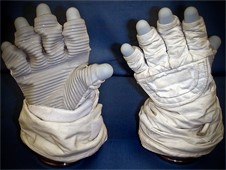
The Extravehicular Mobility Unit (EMU) has many parts, all made in different sizes to fit a wide range of astronauts. “Extravehicular” means “outside of the vehicle” — or, in the case of today's astronauts, outside the International Space Station. This suit is basically a personal spacecraft designed to protect an astronaut from the dangers of Space.
Read on for information about the Upper Torso Assembly, and the parts that attach to it.
Upper Torso Assembly

The Upper Torso is composed of the Hard Upper Torso and the Arm Assembly.
Hard Upper Torso


The Hard Upper Torso (HUT) covers the astronaut's chest and back. It is essentially a vest made of fibreglass. Other components, such as the Displays and Control Module (DCM) and the Primary Life Support System (PLSS), attach to this section.
Displays and Control Module

The Displays and Control Module (DCM) is a control panel fitted to the chest portion of the suit. An astronaut can operate the Primary Life Support System on the back of the HUT from this control panel, while also accessing pressure, temperature and communications controls. All the words on the controls are written backwards, and are read by using a mirror on the astronaut's wrist.
Primary Life Support Subsystem

The Primary Life Support Subsystem (PLSS) is worn on the astronaut's back. It includes oxygen tanks and components that remove exhaled carbon-dioxide, as well as a battery for electrical power, water-cooling equipment, a fan for circulating oxygen, a two-way radio, and the caution and warning system. The whole thing is then covered with layers of protective fabric.
And you thought your school backpack was heavy!
SAFER

“SAFER” stands for Simplified Aid for EVA Rescue.
A spacewalk is an Extravehicular Activity (EVA). In this case “extra” means being outside the vehicle — which in this case is the spacecraft or Space Station.
Astronauts are usually connected to the craft or station by a tether. If the tether breaks or becomes detached, they can use nitrogen thrusters in the SAFER to propel themselves back to safety. There is a small joystick for directional control.
The SAFER attaches to the bottom of the Primary Life Support Subsystem on the astronaut's back.
Arm Assembly

There are different sizes of Arm Assembly parts, with sizing rings to make them longer or shorter for astronauts of various sizes.
EVA Gloves

The EVA Gloves are connected to the suit by a “bearing” that also allows the wrist to turn. Each glove has heaters in the fingertips to keep the astronaut’s hands warm — don’t you wish your gloves had these? The outer portion of the fingertips is made of rubber, which gives astronauts a better sense of touch when working with tools.
Wrist Mirror

Imagine looking down at your chest, and trying to read writing on the front of a box stuck to your shirt.
To make them easier to read, the words on the dials and controls of the Display and Controls Module are printed backwards. The astronauts read them using a Wrist Mirror.
Cuff Checklist

You are never too smart to need a checklist or use reminders! Astronauts are very skilled and very smart, but when they go on a spacewalk, they carry a list of everything they need to do, attached to one of their wrists. This is known as the Cuff Checklist.
